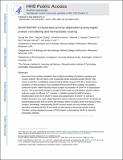GKAP orchestrates activity-dependent postsynaptic protein remodeling and homeostatic scaling
Author(s)
Shin, Seung Min; Zhang, Nanyan; Hansen, Jonathan; Gerges, Nashaat Z; Pak, Daniel TS; Sheng, Morgan; Lee, Sang H; ... Show more Show less
DownloadAccepted version (2.340Mb)
Open Access Policy
Open Access Policy
Creative Commons Attribution-Noncommercial-Share Alike
Terms of use
Metadata
Show full item recordAbstract
How does chronic activity modulation lead to global remodeling of proteins at synapses and synaptic scaling? Here we report that guanylate kinase-associated protein (GKAP; also known as SAPAP), a scaffolding molecule linking NMDA receptor-PSD-95 to Shank-Homer complexes, acts in these processes. Overexcitation removes GKAP from synapses via the ubiquitin-proteasome system, whereas inactivity induces synaptic accumulation of GKAP in rat hippocampal neurons. Bidirectional changes in synaptic GKAP amounts are controlled by specific CaMKII isoforms coupled to different Ca 2+ channels. CaMKIIα activated by the NMDA receptor phosphorylates GKAP Ser54 to induce polyubiquitination of GKAP. In contrast, CaMKIIβ activation via L-type voltage-dependent calcium channels promotes GKAP recruitment by phosphorylating GKAP Ser340 and Ser384, which uncouples GKAP from myosin Va motor complex. Overexpressing GKAP turnover mutants not only hampers activity-dependent remodeling of PSD-95 and Shank but also blocks bidirectional synaptic scaling. Therefore, activity-dependent turnover of PSD proteins orchestrated by GKAP is critical for homeostatic plasticity. © 2012 Nature America, Inc. All rights reserved.
Date issued
2012Department
Massachusetts Institute of Technology. Department of Brain and Cognitive SciencesJournal
Nature Neuroscience
Publisher
Springer Science and Business Media LLC
Citation
Shin, S. M., et al. "Gkap Orchestrates Activity-Dependent Postsynaptic Protein Remodeling and Homeostatic Scaling." Nature Neuroscience (2012).
Version: Author's final manuscript